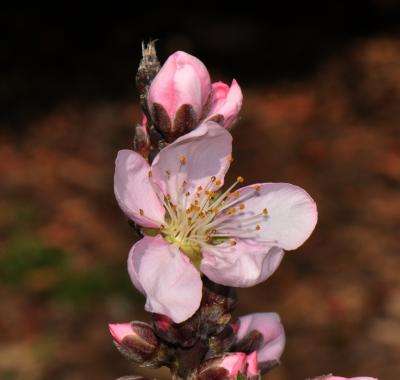Peach genome offers insights into breeding strategies for biofuels crops

Rapidly growing trees like poplars and willows are candidate "biofuel crops" from which it is expected that cellulosic ethanol and higher energy content fuels can be efficiently extracted. Domesticating these as crops requires a deep understanding of the physiology and genetics of trees, and scientists are turning to long-domesticated fruit trees for hints. The relationship between a peach and a poplar may not be obvious at first glance, but to botanists both trees are part of the rosid superfamily, which includes not only fruit crops like apples, strawberries, cherries, and almonds, but many other plants as well, including rose that gives the superfamily its name.
"The close relationship between peach and poplar trees is evident from their DNA sequence," said Jeremy Schmutz, head of the Plant Program at the U.S. Department of Energy Joint Genome Institute (DOE JGI).
In the March 24 edition of Nature Genetics, Schmutz and several colleagues were part of the International Peach Genome Initiative (IPGI) that published the 265-million base genome of the Lovell variety of Prunus persica.
"Using comparative genomics approaches, characterization of the peach sequence can be exploited not only for the improvement and sustainability of peach and other important tree species, but also to enhance our understanding of the basic biology of trees," the team wrote. They compared 141 peach gene families to those of six other fully sequenced diverse plant species to unravel unique metabolic pathways, for instance, those that lead to lignin biosynthesis—the molecular "glue" that holds the plant cells together—and a key barrier to deconstructing biomass into fuels.
For bioenergy researchers, the size of the peach genome makes it ideal to serve as a plant model for studying genes found in related genomes, such as poplar, one of the DOE JGI's Plant Flagship Genomes, and develop methods for improving plant biomass yield for biofuels.
"One gene we're interested in is the so-called "evergreen" locus in peaches, which extends the growing season," said Daniel Rokhsar, DOE JGI Eukaryotic Program head under whose leadership sequencing of the peach genome began back in 2007. "In theory, it could be manipulated in poplar to increase the accumulation of biomass."
The publication comes three years after the International Peach Genome Consortium publicly released the draft assembly of the annotated peach genome on the DOE JGI Plant portal Phytozome.net and on other websites. The decision to sequence the peach genome was first announced during the 2007 Plant and Animal Genome XI Conference.
In the United States, the Initiative was funded by the U.S. Department of Energy Office of Science and led by researchers at the DOE JGI, The HudsonAlpha Institute for Biotechnology, Clemson University, North Carolina State University, and Washington State University. Additional support was contributed by U.S. Department of Agriculture and by the Energy Biosciences Institute, of the University of California, Berkeley, who supported senior author Therese Mitros. The Italian government also supported this international effort, including the work of first author Ignazio Verde of the Fruit Tree Research Centre/Agricultural Research Council in Rome, Italy. Contributions were also made from research institutes in Chile, Spain, and France.
More information: genome.jgi.doe.gov/programs/pl … flagship_genomes.jsf.
Journal information: Nature Genetics
Provided by DOE/Joint Genome Institute




















